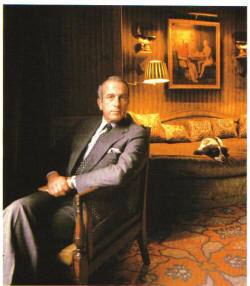

Partner Fulco, Duke of Verdura, Klaus Scheinart
Queer Places:
39 Brook St, London W1K 4JE, UK
La Casella, 15 Chem. du Moulin, 06650 Opio, France
 Thomas
Simon "Tom" Parr (July 11, 1930 - July 29, 2011) was born in London on July 11
1930 . His father had been badly wounded in the Great War and never recovered
his health, dying when Tom was a boy. Tom’s mother, Vere, from whom he
inherited his taste and sense of humour, then married Sir Antony Burney, a
director of the Debenhams Group and thus ideally placed to guide his stepson’s
career.
Thomas
Simon "Tom" Parr (July 11, 1930 - July 29, 2011) was born in London on July 11
1930 . His father had been badly wounded in the Great War and never recovered
his health, dying when Tom was a boy. Tom’s mother, Vere, from whom he
inherited his taste and sense of humour, then married Sir Antony Burney, a
director of the Debenhams Group and thus ideally placed to guide his stepson’s
career.
After leaving Radley, Tom did his National Service in the Army. His first job was in the antiques department of the General Trading Company, founded in 1920 and one of London’s first “boutique” home stores. Then, in the early 1950s, he launched himself on the interior decorating scene by going into partnership with the young David Hicks, initially in the round building then known as The Gasometer, in Lowndes Street, Belgravia.
There, after years of dowdy rep, faded cretonnes and Fablon, London society was dazzled by the simplicity of, say, two dozen Zulu warriors’ lances hung horizontally; stainless steel and tan leather chairs; vast baroque marble torsos dramatised by megawatt uplighters — all set on pale rugs from Cogolin.
Together Hicks and Parr revived the pre-war palette of Syrie Maugham and blended it with American Modernism: white on white, neutral with neutral, stabbed with hot pinks and lime green. As the trend-obsessed wife of the celebrated fashion photographer John French exclaimed: “When Hicks and Parr said 'beige’, who was I to lag behind?”
Parr was from his youth an inveterate traveller, visiting the countries, cities and houses that had been inaccessible during the years of the Second World War.
His social grace gained him an entrée to the grandest and most amusing salons; and it was while visiting the Agnellis that Parr met the great Sicilian jeweller Fulco, Duke of Verdura, who was to become his companion and influence for many years.
By this time David Hicks’s star had rocketed; his persuasive eye, personality and looks had brought about a dazzling engagement, engineered by Chips Channon, to the Queen’s favourite cousin, Lady Pamela Mountbatten. Hicks had no relatives apart from his mother — and when asked who would be on the groom’s side in Romsey Abbey, Tom loyally replied: “Well, Ma and Parr, I suppose.”
In 1960, following the disbanding of Hicks and Parr, Tom Parr acquired a partnership share in Colefax and Fowler. This brought a much needed infusion of cash into the company, enabling the purchase on his advice of the lease of 39 Brook Street, the Mayfair showroom synonymous with the company ever since.
During the years after John Fowler’s retirement, Parr’s sound business judgment, coupled with his taste, saw the firm transformed from a loss-making yet distinguished decoration and antiques company to a commercially sound enterprise, with the sales of material, wallpaper and carpeting . It was sold in 1984 and launched on the stock market the following year; Parr served as chairman until his retirement in 1996.
Parr was a memorable presence at 39 Brook Street, notable for his towering height, elegance of dress, formidable intelligence and great wit — plus his vigorous approach to management.
His temper was famous (not for nothing was the landing outside his office known as “Flak Alley”) and the staircase frequently ran with tears; yet there was also endless laughter, and, by those who survived the storms, he was much revered and loved.
Parr decorated for a legion of worldwide clients, from Dame Vivien Duffield to members of the Ford dynasty and Chateau Latour. Many of his clients became lifelong friends, among them the Duke and Duchess of Beaufort at Badminton, where Parr was to achieve some of his finest work.
Fulco Verdura died in 1978, and soon afterwards Parr met the Munich businessman Klaus Scheinart, with whom he bought La Casella, a stylish pavilion tucked into a fold of valley near Opio in the Alpes Maritime. There Parr created a series of flower-filled rooms that became a benchmark of simple grandeur. The gardens themselves, under Scheinart’s astute direction, became more structurally ambitious, lusher, and more romantic with every season.
It was at this house that for a decade Tom Parr endured the debilitating effects of Parkinson’s disease. He died on July 29, 2011, and was survived by Klaus Scheinart. Scheinart died in 2015.
My published books: